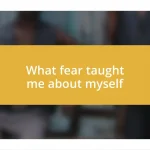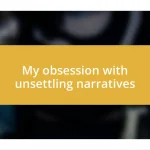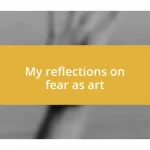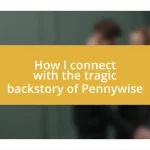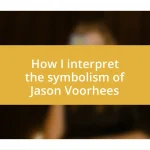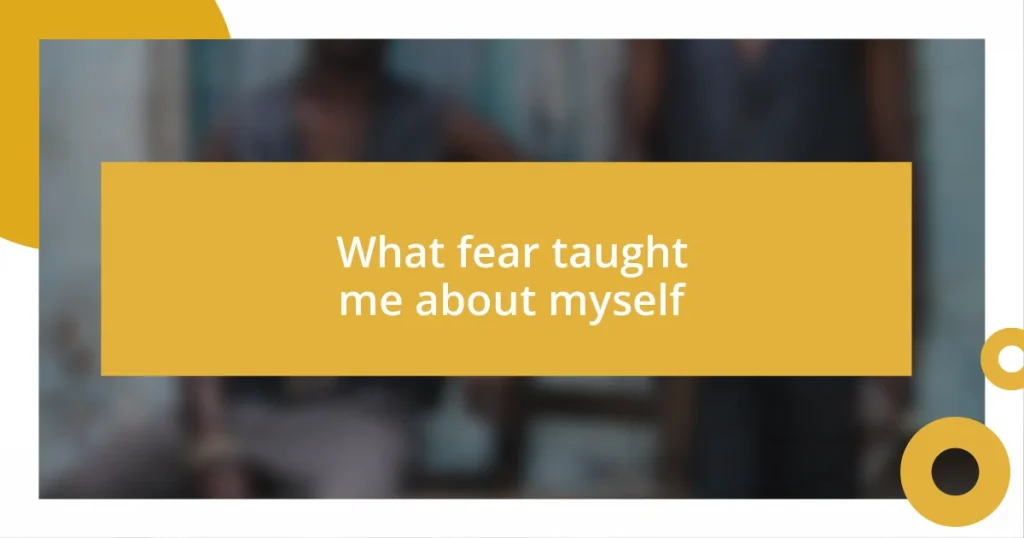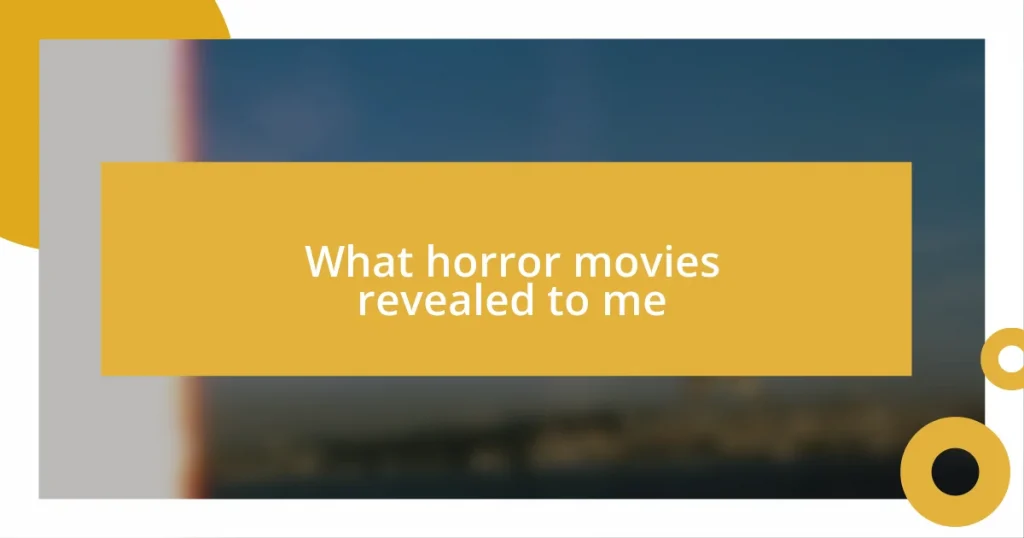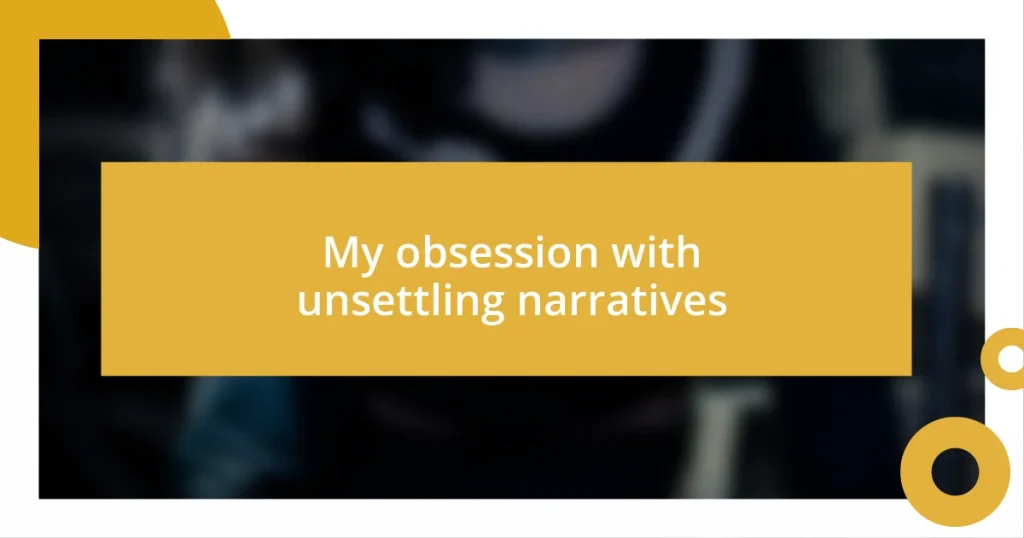Key takeaways:
- The horror genre serves as a mirror for societal fears and norms, particularly concerning women, exploring themes of power, vulnerability, and resistance.
- Iconic horror characters like Laurie Strode and Carrie White embody resilience and reflect broader societal issues regarding women’s roles and empowerment.
- Modern horror films, such as “The Invisible Man” and “It Follows,” tackle contemporary issues like gaslighting and sexual agency, inviting critical dialogues on female experiences and autonomy.
![]()
Understanding feminist themes in horror
When I think about feminist themes in horror, I often reflect on how this genre holds a mirror to societal fears and norms, particularly concerning women. It’s fascinating to see how these films navigate themes of power, vulnerability, and resistance. I remember watching “The Babadook” and feeling an overwhelming sense of empathy for the protagonist, who battles both an external monster and her internal struggles.
This duality exposes how horror can be a unique vehicle for exploring female experiences. Isn’t it intriguing that the monsters in these films often reflect patriarchal pressures? For instance, in “Carrie,” the titular character embodies the stereotypes and alienation that many young women face, and her explosive retaliation is both horrifying and cathartic.
I’ve often asked myself: can horror be a form of empowerment for women? Through characters who confront their fears and societal expectations, these narratives allow viewers to explore complex emotions and reclaim agency in ways that mainstream media often overlooks. It’s a powerful reminder of how horror, despite its frightening elements, can serve as a crucial commentary on the female experience.
![]()
Identifying key horror icons
Identifying key horror icons is essential to understanding the interplay between feminism and horror cinema. Each character often encapsulates specific fears or societal critiques, particularly regarding women’s roles within society. I distinctly remember the first time I encountered the fierce presence of Laurie Strode from “Halloween.” She wasn’t just a victim; she was a fighter, navigating her way through terror with resilience and intelligence, which left me rooting for her all the way through.
Here are some iconic characters that represent various feminist themes in horror:
- Laurie Strode (“Halloween”): Represents survival and the reclaiming of autonomy.
- Carrie White (“Carrie”): Embodies the impact of bullying and societal expectations on young women.
- Nancy Thompson (“A Nightmare on Elm Street”): A symbol of resourcefulness and bravery in the face of terror.
- Regina George’s mother (“Mean Girls”): While not traditionally horror, her character evokes a sense of dread about feminine competition and societal pressures.
- The Babadook: A more subtle representation; the monster parallels mental illness and the struggle for identity as a mother.
Each of these figures evokes complex emotional responses, illustrating the diverse ways horror can challenge or reinforce gender dynamics. Their narratives are not just about survival—they spark critical conversations about identity, power, and societal constraints.
![]()
Analyzing character motivations and roles
When I dive into analyzing character motivations and roles in horror, I often find myself captivated by the backstories that drive these iconic figures. Take, for example, the character of Carrie White; her traumatic experiences push her to resort to extreme measures. I remember feeling a mix of horror and sympathy as I uncovered her motivations, realizing that her rage was a powerful response to the relentless bullying she endured. This connection between trauma and power often fascinates me; it gives depth to characters who might otherwise be seen as mere victims.
Similarly, Laurie Strode’s evolution throughout “Halloween” strikes me as incredibly powerful. Initially portrayed as a typical teenager, her transformation into a survivalist highlights themes of resilience and empowerment. Reflecting on her character, I can’t help but appreciate how her determination not only to survive but to confront the terror showcases a profound commentary on the strength women can summon in the face of danger. It’s this journey from vulnerability to strength that makes her character so relatable and inspiring.
In contrast, characters like Nancy Thompson from “A Nightmare on Elm Street” remind me that resourcefulness is often forged out of necessity. Her strategic thinking against Freddy Krueger illustrates the importance of intelligence and bravery, encapsulating a belief that survival is not solely a matter of physical strength but also mental acuity. I often find myself wondering how this blend of character motivations not only reflects individual struggles but also symbolizes broader societal themes regarding women’s independence and agency.
| Character | Motivation/Roles |
|---|---|
| Carrie White (“Carrie”) | Driven by trauma and bullying, confronts her pain through powerful rage. |
| Laurie Strode (“Halloween”) | Transforms from victim to survivor, embodying resilience and empowerment. |
| Nancy Thompson (“A Nightmare on Elm Street”) | Utilizes intelligence and bravery to navigate her fears and fight back. |
![]()
Exploring gender dynamics in narratives
The exploration of gender dynamics within horror narratives often reveals a fascinating interplay of power and vulnerability. When I reflect on iconic horror films, I can’t help but notice how women frequently navigate environments filled with male aggression and societal expectations. For example, I vividly remember the moment in “Halloween” when Laurie Strode outsmarts Michael Myers. It struck me that her ability to adapt and confront such chilling terror signifies more than mere survival; it raises questions about female agency in a male-dominated narrative landscape.
As I delve deeper into these characters, it becomes evident that their experiences resonate with our cultural anxieties regarding femininity. In films like “Carrie,” we see a young woman’s rage unleashed in the face of relentless bullying, which reflects a broader commentary on the pressures placed on women to conform. During my own teenage years, I often felt the weight of societal expectations, and witnessing Carrie’s transformation was both terrifying and cathartic. It prompts the question: What happens when a woman snaps under the pressure of her circumstances, and how can that be seen as a rebellion against imposed norms?
These narratives are rich with opportunities to challenge conventional gender roles. Characters like Nancy Thompson show us that intelligence and resourcefulness are just as crucial for survival as physical strength. I remember discussing this with friends after watching “A Nightmare on Elm Street” for the first time. We all felt empowered by Nancy’s clever strategies, recognizing that true strength doesn’t always manifest through brawn. It made me reflect on the importance of not only acknowledging women’s vulnerabilities but also celebrating their triumphs over adversity within these haunting tales.
![]()
Examining societal fears and implications
When I consider the societal fears depicted in horror films, it’s fascinating to see how they mirror real-world anxieties. For instance, the fear of female empowerment often surfaces in narratives where women confront unrelenting terror, like in “The Babadook.” Upon my first viewing, I felt a visceral jolt when the protagonist, Amelia, wrestled with her grief while battling a malevolent force. It made me wonder: are we truly afraid of the monsters lurking in the dark, or are we more terrified of what happens when women reclaim their power in defiance of societal expectations?
Horror icons often embody societal fears surrounding femininity and autonomy, challenging our collective psyche. In films like “Misery,” Kathy Bates’ character forces the issue of female rage and control, showcasing how society can demonize strong women. I vividly remember discussing this film with a friend, and we both reflected on how an assertive woman is often painted as a villain. It raises a critical question: What does it say about our culture when a woman’s strength is viewed as something monstrous rather than empowering?
These themes are packed with implications for understanding societal norms and gender dynamics. While characters like Laurie and Nancy exhibit strength against their adversaries, they also navigate the societal expectations that dictate how women should behave. I found myself contemplating the layers in “Halloween,” realizing that it’s not just about who survives, but also about how these narratives reshape our understanding of female resilience. Isn’t it intriguing how horror can serve as a mirror, revealing both our deepest fears and our potential for empowerment?
![]()
Connecting feminist theory to horror
The connection between feminist theory and horror is striking, revealing how both explore the complexities of female identity within a patriarchal framework. I often think about how horror films force viewers to confront uncomfortable truths about gender dynamics. When I watched “Hereditary,” I was struck by the way the female characters navigated trauma and inherited pain. It made me question how often women shoulder the burdens of their families while grappling with their own demons—quite literally in this case.
Horror also provides a platform for female characters to express rage and defiance. I recall a particularly powerful moment in “Get Out” when the main character’s girlfriend, Rose, flips from supportive partner to the embodiment of betrayal. This transformation resonated with me deeply because it underscores how societal norms can distort relationships and reveal the hidden threats even within our closest connections. Why do we rarely talk about how women’s anger is often stigmatized? Horror challenges that narrative by depicting it openly, inviting us to reconsider how we interpret female emotions.
Through horror, we encounter the complexities of women’s experiences and the societal fears surrounding them. The genre invites a dialogue on the consequences of female empowerment, especially in films like “The Witch,” where the protagonist’s journey toward self-discovery is met with hostility. I remember feeling a chill as the other characters’ reactions highlighted the fear of women stepping into their own power. It’s these frightening yet poignant moments that compel us to rethink our beliefs about womanhood and the power dynamics at play. Isn’t it fascinating how horror, through its unsettling narratives, encourages us to peel back the layers of societal expectations?
![]()
Applying analysis to modern examples
Applying feminist analysis to modern horror icons reveals a rich tapestry of themes and nuances. Take “It Follows,” for example; I was struck by how the film portrays the anxieties around sexual agency and the societal pressures placed on women’s bodies. Watching the protagonist, Jay, grapple with a relentless force after her sexual encounter reminded me of how often society seeks to control women’s sexuality. Doesn’t it make you think about the fear of female desire and the consequences that come with embracing it?
In “The Invisible Man,” the narrative takes a bold step by transforming the classic tale of a male predator into a commentary on gaslighting and domestic abuse. As I watched Cecilia navigate her harrowing experience, I couldn’t help but feel her isolation—it mirrored the very real struggles many women face when their voices are silenced. Reflecting on her fight to reclaim her own reality and power left me wondering: are we finally starting to address the horrors that women face both on screen and in everyday life?
Then there’s “A Girl Walks Home Alone at Night,” which marries horror with a feminist lens in a beautifully unique way. I remember the first time I viewed it; the image of a female vampire roaming the streets of an Iranian ghost town resonated deeply with me. Here’s a character defined not by her fear but by her hunt for agency and autonomy. It challenges the archetype of the terrified female, instead presenting a empowering figure that makes you ask, how can horror not only invoke fear but also inspire strength?
